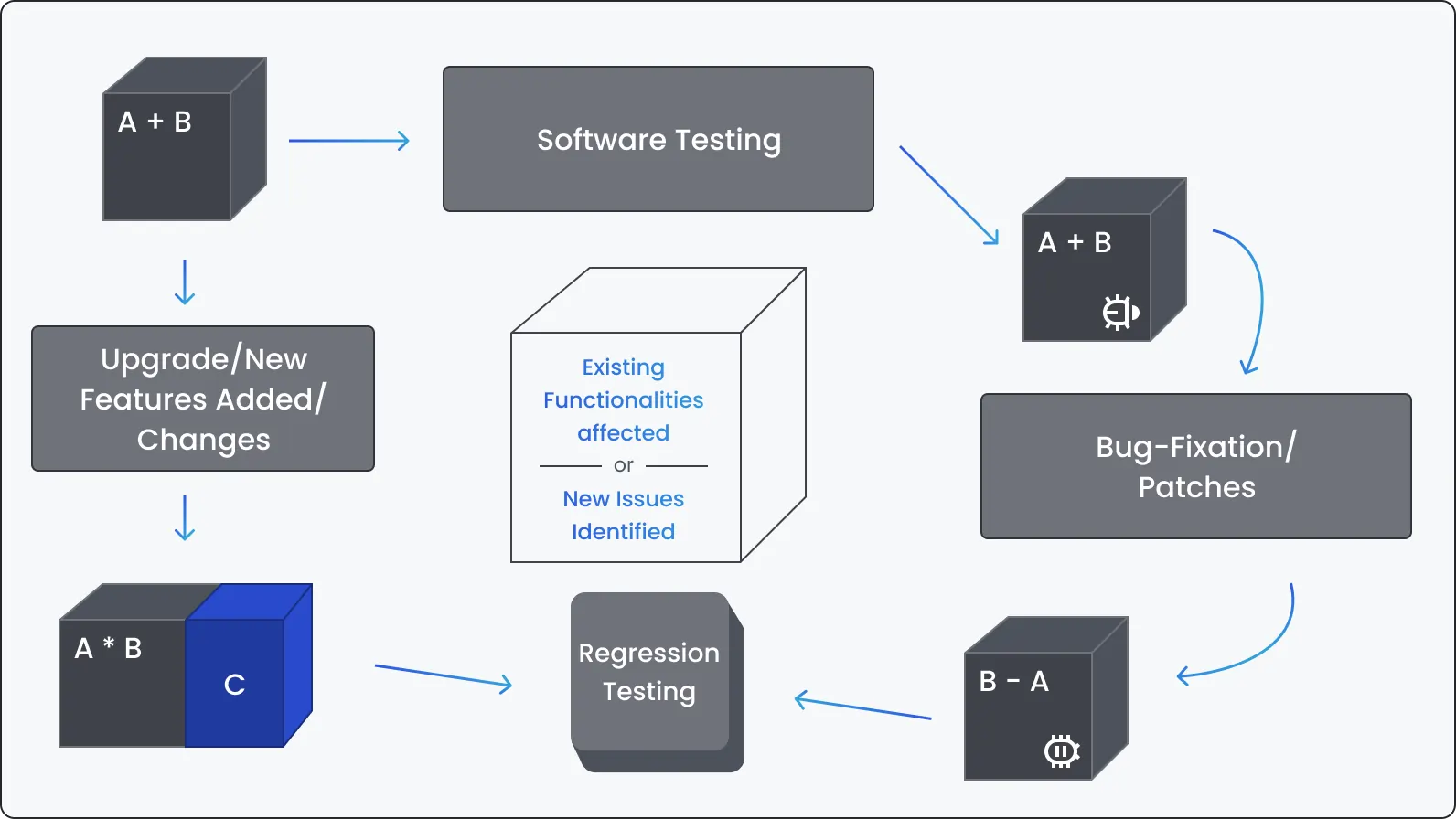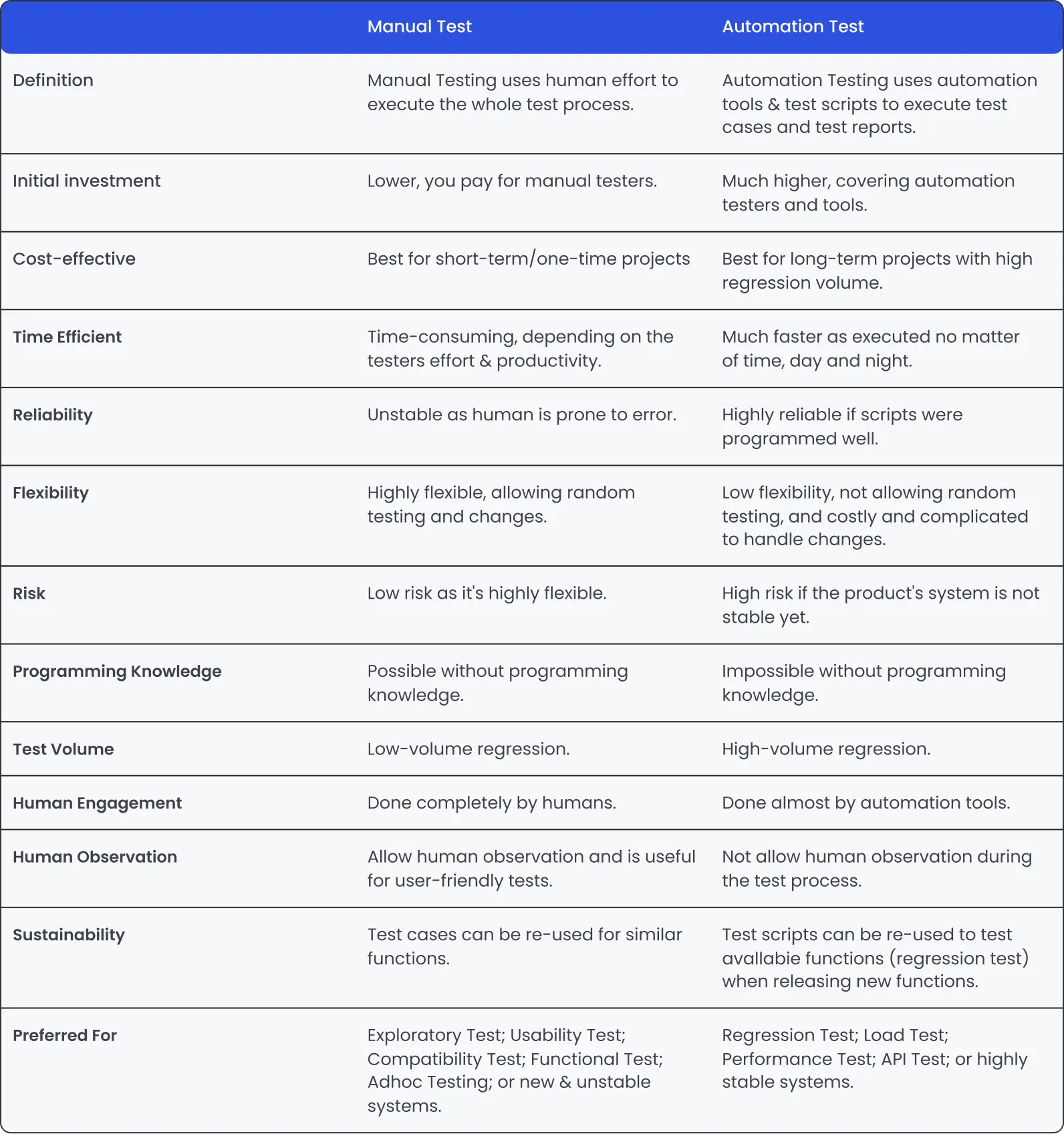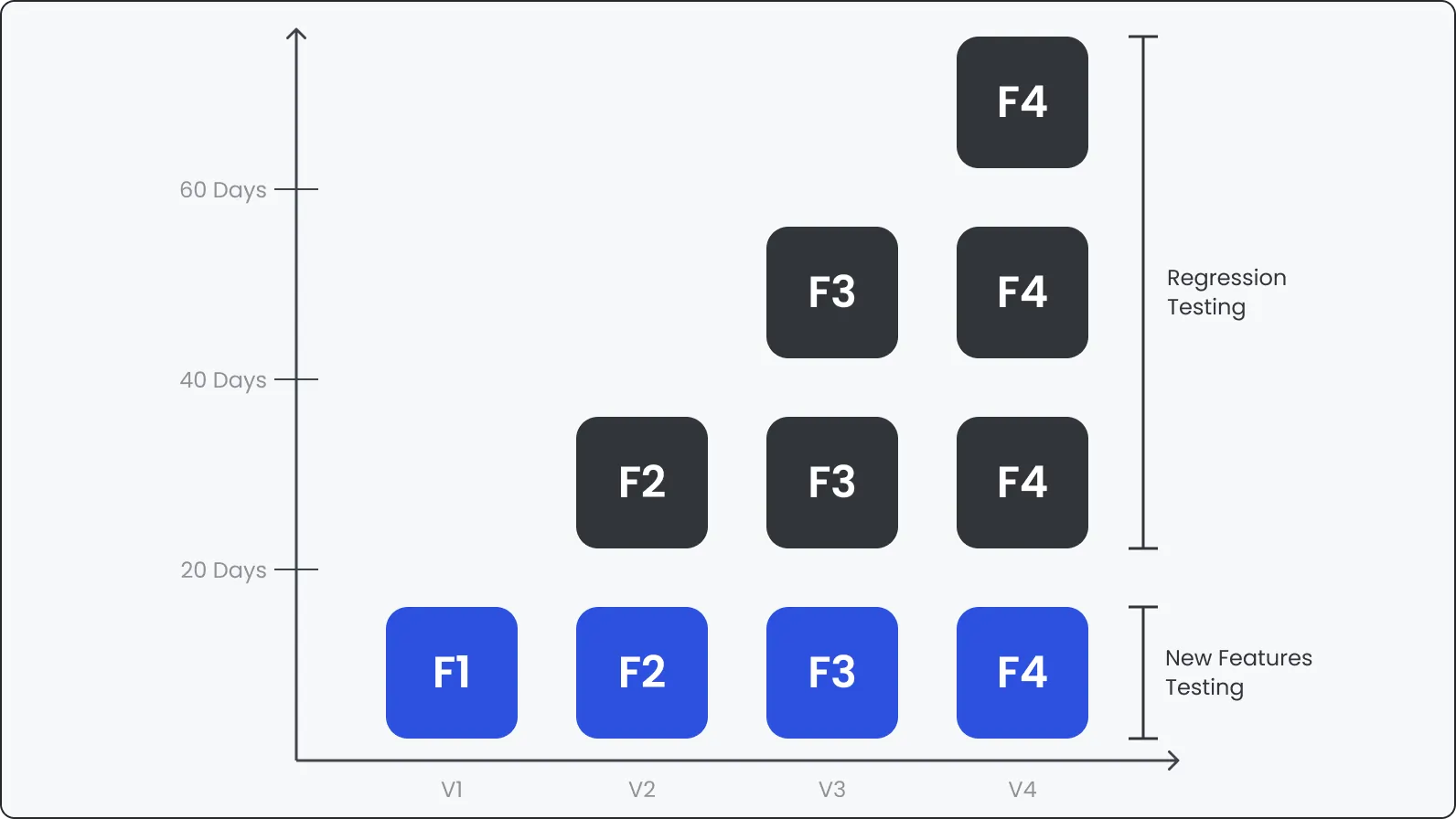14 minutes to read
Automated Regression Testing: A Detailed Guide


Ievgen Ievdokymov
Senior QA Engineer
Let's set out what automated regression testing is with a practical comparison. It is a bit strange, but because of this, it will be understandable even to a non-technical person.
Think of anyone who suffers from OCD (obsessive-compulsive disorder). One of the characteristics of this disorder is that sufferers often double-check (or even dozen-check) whether they have closed the doors, turned off the gas in the kitchen or the iron in the bedroom. They need these "checks" in order to calm down and feel that everything is okay.
Regression testing is like such double-checks. In simple words, it is when QAs run the test again to make sure that the code changes have not affected it and that the functionality of the software works as it should.
However, running such tests manually is a time-consuming and dangerous thing. Just imagine that a tester makes a mistake while conducting a test. This way, the very idea of double-checking loses its purpose and hence effectiveness.
And that’s where automated regression tests come into play.

What Is Automated Regression Testing?
Regression testing automation is just using special tools and scripts to repeatedly execute several tests on a software application without direct human participation.
And now, recall our comparison from the introduction. OCD patients want to make sure everything's okay. Similarly, automated regression testing software aims to ensure that new changes or updates to the application don’t harm its functionality.
Regression testing is a crucial component of the software development lifecycle (SDLC), as it helps development teams identify and fix potential problems early in the process, reducing the likelihood of costly errors and system downtime.

Manual vs. Automated Regression Testing: The choice may not be obvious. Yet, it is often quite simple: if you have a small-scale project, choose manual testing. If you have a large project you can't do without automation, it will help you save both time and resources.
Regression Testing vs. Other Testing Techniques: It’s not a matter of OR but rather a matter of AND. Because you can’t replace other tests and automate regression testing only. Also, other methods primarily focus on specific aspects of the application (like functional testing, for example), regression testing addresses the entire system, ensuring that any changes made do not negatively impact the overall functionality or stability of the software.
John Micco from Google at the International Conference in Software Testing, Verification, and Validation (ICST) in 2017 revealed that at the tech giant, devs are running 4.2M individual tests continuously. On average, it evolves in 150M tests per day. With such amount of tests, the prioritization issue arises. And regression testing must be a top priority, at least because some studies prove that up to 70% of bugs appear after code changes.
Building confidence through automated regression testing
When Does Your Product Need Automated Regression Testing?
Let’s continue our explanations by comparing regressing automation to general things. Imagine you are up to go skydiving. Then, the parachute is like your software. You wouldn't jump without first (and repeatedly) checking the slings, stowage, etc., would you? Similarly, you shouldn't release software to a wide audience without multiple tests. You could ignore it, but savvy divers know it's a sign to “pop the hood” and ensure everything's packed correctly.

But let's face it, even the smoothest software development process can hit bumps. A seemingly minor code tweak can turn a feature into a nightmare, irritating users and lowering all the KPIs. But we have automated regression testing for that reason.
Here are some cases when your product needs it most:
You update and improve the product very often: If your software requires regular updates and improvements to stay competitive or relevant, automated regression testing can help maintain its stability and reliability during these changes. This is particularly important if your product has a short development cycle, as frequent updates may introduce new bugs or issues that could impact the user experience. As we have already said, some studies show 70% of bugs resurface after code changes.
You build complex software: You always keep up with the newest trends and pack your software with bedazzling features. You build it up over and over again and end up with a software skyscraper. On the one hand, that’s great! But on the other… With evolving, your software still needs to be tested in all possible scenarios and edge cases. And manually, it could be challenging. Automated regression testing increases test coverage, ensuring that your software remains robust and reliable.
You attract more and more users: Broadening your client base is a great sign of the quality of your product. The more clients trust you, the more profit you get. But there is also a risk — any errors or instability can have significant consequences. Both reputable and in terms of money. Regression testing automation helps identify and fix any bugs quickly.
Continuous integration and deployment: Using DevOps? Great! You definitely need automated regression testing, then. In a continuous integration and deployment (CI/CD) environment, risks of changes affecting the functionality skyrocket. But if you integrate regression testing into your CI/CD pipeline, you’ll get extra confidence that your software remains stable and reliable.
Types of Regression Testing
Looking back at our medical metaphor, choosing the right type of regression test is just like a doctor using different tools for different ailments. Each type focuses on a specific aspect of your software's “health”. There are several types of regression testing, each with its own benefits, challenges, and nuances.

Be careful when choosing the test type. Oh, easier said than done, right? But wind down, there is no silver-bullet test. The most effective regression testing strategy combines different approaches based on your specific needs and application complexity.
How to Automate Regression Testing in Your Project in 10 Steps
You are on the right track if you decided to leverage automated regression testing in your project. Among other benefits, it can significantly improve the efficiency and reliability of your software development process. Below is a step-by-step guide to help you integrate automated regression testing effortlessly. For your convenience and awareness, we added practical tips, tricks, and proof.
1/ Assess Test Needs
Before firing a single test script, understand your enemy — the current bottlenecks of your SDLC. Assess code complexity, existing test coverage, and user base size. A one-size-fits-all approach won't cut it here but try to notice sophisticated elements in the entire process — focus on repetitive and time-consuming scenarios that are crucial for maintaining the app's stability.
Pro Tip: Leverage instruments like the Pareto Principle to identify the 20% of tests contributing to 80% of issues.
2/ Select the Right Tool
Choose an automation regression testing tool that aligns with your project's requirements. Note the tool must be compatible with your current tech stack, consider also the ease of integration and community support.
Statistical Insight: According to the State of Testing report, Selenium remains popular, covering 39% of automated testing usage.
3/ Set Up Certain Objectives
Clearly outline what you aim to achieve, be it faster release cycles, enhanced test coverage, or improved software quality. The answer will shape your future process.
The Case: Amazon significantly reduced testing time and increased test coverage by implementing automated regression testing. But the main idea is that covered lines don’t matter, the ones not covered do.
4/ Develop a Robust Test Suite
Your test suite must cover critical functionalities. Ensure each test case is modular and easily maintainable and that you can run them independently.
Best Practice: Utilize behavior-driven development (BDD) principles to create readable and collaborative test scenarios. Utilize historical defect data and user feedback — this will help you create test cases that address the most critical issues.
5/ You Could Do With Version Control
Control systems like Git aim to manage changes in the test scripts. This ensures accountability, traceability, and collaboration among development and testing teams.
Case Study: Airbnb's engineering team attributes their testing success to the implementation of Git for version control.
6/ Integrate with CI/CD Pipelines
Isolated tests are not a good idea. Speaking from experience, many companies utilize DevOps practices, which means continuous deployment. Integrate automated testing into your pipeline. This way, tests will be executed automatically after each improvement (read as code change).

Benefit Insight: CircleCI’s case study assures that integrated testing decreases infrastructure costs by almost 50%.
7/ Execute Several Tests Simultaneously
The study mentioned above also states that when you conduct several tests at the same time, you can reduce the overall time required by 50% and increase devs’ productivity by 20% in the next iterations. Use different environments to ensure you get a timely feedback loop.
Practical Tip: Leverage cloud-based testing platforms like AWS Services or Jenkins for parallel test execution, minimizing infrastructure bottlenecks.
8/ Tune Test Data Management
Test data is a crucial aspect of overall success. Control data to ensure consistency and repeatability of tests. Consider using synthetic test data or orchestrating test data refresh processes.
Industry Insight: According to Capgemini's World Quality Report, 45% of respondents highlight data management challenges in test environments.
9/ Check and Monitor Consistently
Continuous monitoring is your best friend now. Because it helps to detect and address issues early. Leverage tools that provide insights into test results, performance, and overall “test health”.
Metric Focus: Nothing groundbreaking — monitor test execution time, failure rates, and historical trends. This way, you’ll have enough information for continuous improvement.
10/ Review and Maintenance
When water stays, it spoils. The same story with regression test automation. Regularly review and update your automated regression testing suite. You know about changes in your software, so adjust test cases accordingly. Continuously refining your automation strategy is the shortest way to the mentioned strong software health.
Case Example: Microsoft's Windows and Office teams regularly review and maintain their suits. At first glance, it doesn’t make a difference, but trust us — it does.
Top 10 Tools for Automated Regression Tests
Choosing the right automated regression testing tool is like selecting the appropriate medicine for a doctor. Recall your last visit to the clinic. Doc doesn’t suggest anything before they examine your overall condition. The same story with test automation tools. Your choice depends on your needs, skills, and “the battlefield” — software type.
1/ Selenium WebDriver
Features: Open-source automated web regression testing tool, supports multiple programming languages, extensive browser compatibility.
Advantages: Rich set of functionalities, supporting many programming languages.
Best Suited for: Projects with complex web applications. That case, when you need to ensure your app will run smoothly in Safari, Chrome, Opera, or any other browser.
2/ TestComplete
Features: Supports desktop, web, and mobile application testing. Its object recognition and scripting-free test creation make it a top-of-mind solution for teams with diverse technical skills and a need for cross-platform testing.
Advantages: One-stop-shop in some meanings; seamless integration into CI/CD pipelines.
Best Suited for: End-to-end testing in projects with diverse application types.
3/ Jenkins
Features: Open-source, extensive plugin ecosystem, continuous integration and delivery.
Advantages: Allows to automate repetitive tasks; supports parallel test execution.
Best Suited for: First stages of continuous integration and delivery implementation.
4/ Appium
Features: Open-source; cross-platform (Android and iOS) mobile application testing.
Advantages: Uses standard automation APIs; supports native, hybrid, and mobile web applications.
Best Suited for: In general, it’s the same story as with Selenium since Apium offers mobile application testing across different platforms.
5/ Cypress
Features: The base language required is JavaScript; real-time reloading, built-in time-travel debugging.
Advantages: Many consider Cypress fast and reliable; excellent for testing modern web applications.
Best Suited for: If your web app has fast-changing (or just dynamic) content and complex interactions.
6/ SoapUI
Features: Specialized for API testing; supports REST and SOAP protocols.
Advantages: Allows to create complex scenarios effortlessly; robust reporting capabilities.
Best Suited for: Situations or projects with an accent on API testing.
7/ Katalon Studio
Features:Similarly to TestComplete, it’s another all-in-one testing solution that supports API, web and mobile apps.
Advantages: Comprehensive and user-friendly interface; convenient integration with popular CI tools.
Best Suited for: Projects requiring full-range and software-wide testing.
8/ IBM Rational Functional Tester
Features: Data-driven testing tool that offers many versatile features and testing types themselves, including functional, regression, and GUI testing.
Advantages: Its integration with other IBM products and support for Java and .NET applications make it most effective for organizations with existing IBM software investments.
Best Suited for: IBM-based projects
9/ Jira
Features: Test case management and integration with popular testing tools.
Advantages: Efficient test case tracking; collaboration between development and testing teams.
Best Suited for: If you are about to use Atlassian tools and require comprehensive test case management, Jira should be a top-of-mind solution.
10/ Tricentis Tosca
Features: Model-based test automation; supports end-to-end testing.
Advantages: All-out test case design; with it, you can accelerate the automation process.
Best Suited for: Enterprises with complex applications and a need for accelerated end-to-end testing.
Automated Regression Testing Best Practices
Any business is interested in providing its clients with the best experience possible. Including the convenience of booking, paying, or any other interaction with the company through its app. So reliability and stability of your software should become the top-one priority. For this reason, you need to optimize your testing processes, including automated regression testing. Let’s run through six best practices and tips to help you maximize the effectiveness of this optimization:
Maintain a robust test suite: Regularly review and update your test suite to ensure it remains relevant and effective. With software evolving, remove obsolete tests and add new ones to cover changes and new features.
Embrace a data-driven approach: Use data sources out of your typical suite to drive different test scenarios. This way, you are able to maximize coverage without duplicating scripts. Imagine one script handling multiple configurations like a chameleon adapting to its environment.
Integrate testing into CI/CD pipelines: Regression test automation mustn’t be in isolation. Place it into your continuous integration and continuous deployment (CI/CD) pipelines where they must be. This step is crucial to ensure that tests are executed consistently and efficiently.
Analysis, analysis, analysis: We won’t be tired of repeating this. Because you can’t find ways to improve without a clear and whole test picture. Set up processes for monitoring and analyzing the results of your automated regression tests to identify potential issues and areas for improvement.
Team up with other teams: Create an atmosphere of complete trust and understanding. Only this way you can ensure collaboration between development, testing, and operations teams. Everyone will be aligned on testing objectives and will be able to work together to address any issues.
Invest in your employees: Nowadays, training compensation is not a perk. Because when your employees get stronger in skills, you get stronger in profit. Provide comprehensive training and support to your development and testing teams to ensure that they are equipped with the necessary skills and knowledge, and the results won’t be long to come.
It’s only your capability to ensure that your automated regression testing efforts are aligned with your project's overall quality and reliability goals. But we can’t help but emphasize the importance of a reliable software testing partner.
To Sum It Up
Regression automation is a critical step toward modern software development. With stable and reliable software, you can attract new clients and increase the satisfaction score of existing ones. Let’s run through key takeouts of the article.
Strategic Tool Selection: Define your goals, clarify your top-priority needs, and let’s go. Choose automated regression testing software and regression testing tools that align with your project's needs.
Holistic Testing Approach: Embrace diverse types of regression testing to cover all facets of your application.
Integration in CI/CD: Remember, automated regression testing shouldn’t exist for the plot. Embed it into your CI/CD pipeline for profitable results.
Continuous Improvement: Regularly review, update, and optimize your testing processes for ongoing efficiency.
These steps can minimize the risk of costly errors and system downtime, ultimately leading to better business outcomes and more secure investment in technology. And if you need a reliable software testing partner, you can book a call with the DeviQA team. Or start with our case studies.
Consistent automation testing for reliable software releases
